2019译林版高中英语选择性必修一Unit 4 Exploring poetry 单词表
- 格式:docx
- 大小:28.33 KB
- 文档页数:3
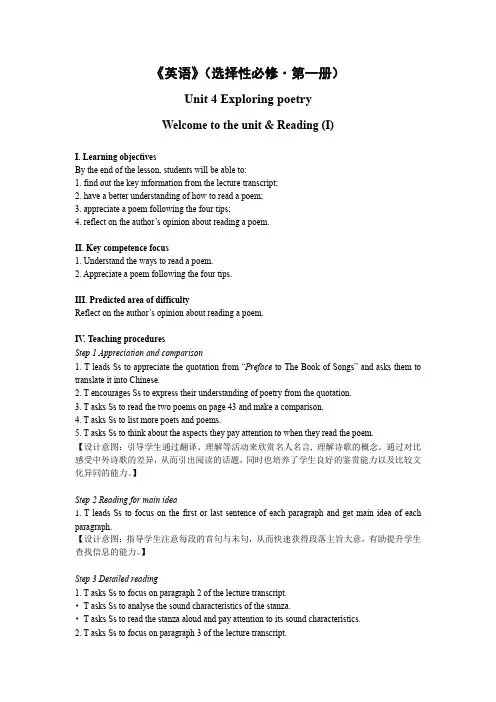
《英语》(选择性必修·第一册)Unit 4 Exploring poetryWelcome to the unit & Reading (I)I. Learning objectivesBy the end of the lesson, students will be able to:1. find out the key information from the lecture transcript;2. have a better understanding of how to read a poem;3. appreciate a poem following the four tips;4. reflect on the author’s opinion about reading a poem.II. Key competence focus1. Understand the ways to read a poem.2. Appreciate a poem following the four tips.III. Predicted area of difficultyReflect on the author’s opinion about reading a poem.IV. Teaching proceduresStep 1 Appreciation and comparison1. T leads Ss to appreciate the quotation from “Preface to The Book of Songs” and asks them to translate it into Chinese.2. T encourages Ss to express their understanding of poetry from the quotation.3. T asks Ss to read the two poems on page 43 and make a comparison.4. T asks Ss to list more poets and poems.5. T asks Ss to think about the aspects they pay attention to when they read the poem.【设计意图:引导学生通过翻译、理解等活动来欣赏名人名言, 理解诗歌的概念。
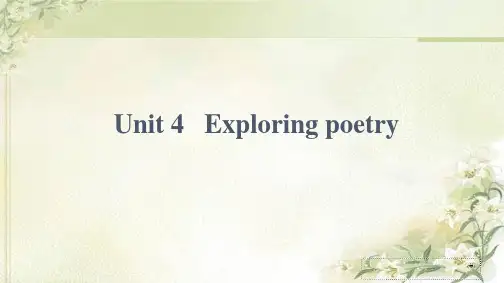
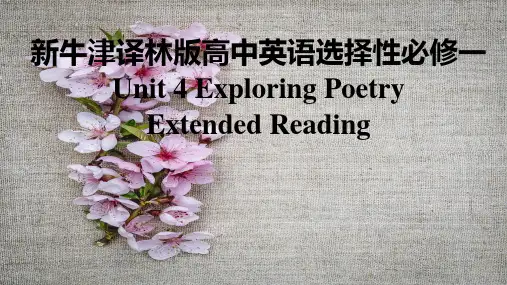
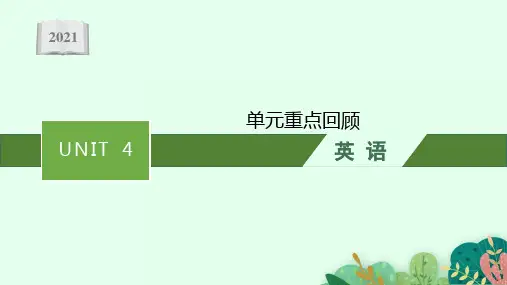
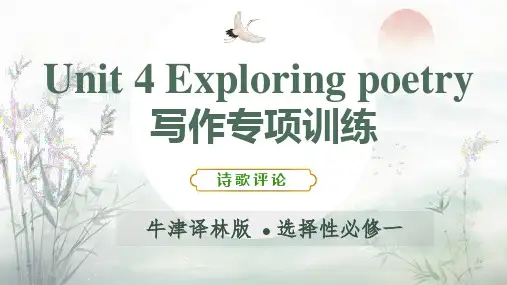
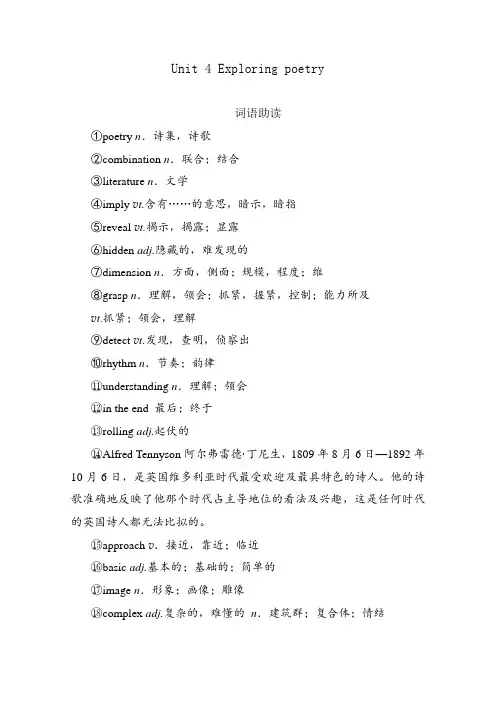
Unit 4 Exploring poetry词语助读①poetry n.诗集,诗歌②combination n.联合;结合③literature n.文学④imply v t.含有……的意思,暗示,暗指⑤reveal v t.揭示,揭露;显露⑥hidden adj.隐藏的,难发现的⑦dimension n.方面,侧面;规模,程度;维⑧grasp n.理解,领会;抓紧,握紧,控制;能力所及v t.抓紧;领会,理解⑨detect v t.发现,查明,侦察出⑩rhythm n.节奏;韵律⑪understanding n.理解;领会⑫in the end 最后;终于⑬rolling adj.起伏的⑭Alfred Tennyson阿尔弗雷德·丁尼生,1809年8月6日—1892年10月6日,是英国维多利亚时代最受欢迎及最具特色的诗人。
他的诗歌准确地反映了他那个时代占主导地位的看法及兴趣,这是任何时代的英国诗人都无法比拟的。
⑮approach v.接近,靠近;临近⑯basic adj.基本的;基础的;简单的⑰image n.形象;画像;雕像⑱complex adj.复杂的,难懂的n.建筑群;复合体;情结⑲contradictory adj.相互矛盾的,对立的⑳surroundings n.周围的环境surrounding adj.周围的,四周的surround v t.包围;围绕;环绕21dig up 发现,搜集,查明○22clue n.线索,提示;迹象○23fearful adj.吓人的;可怕的○24trill n.(鸟的)啼啭;颤音○v t.欢快地高声说v i.发颤音25Maya Angelou玛雅·安吉洛,1928年4月4日出生于美国密苏里○州圣·路易斯市。
美国黑人作家、诗人、剧作家、编辑、演员、导演和教师。
26interpret v t.解释,阐释;把……理解为,领会;演绎○v i.口译27painstaking adj.艰苦的;辛苦的○28patience n.耐心,忍耐力○29set sth.aside把……放一边;留出○30remote adj.偏远的,偏僻的;遥远的,久远的;远亲的○31destination n.目的地○32discovery n.发现,发觉;被发现的人或物○33reward v t.奖励,奖赏n.奖励,回报;悬赏金○34constantly ad v.连续地;不断地○35previously ad v.先前;以前;(一段时间)以前○36constantly ad v.始终,一直○37previously ad v.先前;(一段时间)以前○38logical adj.符合逻辑的;必然的,合乎情理的○39inner adj.内心的,隐藏的;里面的,内部的○40as long as只要○41perceive v t.注意到,意识到;将……理解为,将……视为○42everlasting adj.永久的;永恒的○课本原文How to read a poemPoetry①is a combination②of “sound”and “sense”.More than any other type of literature③,it usually implies④a deeper meaning beyond the words on the page.So,how to reveal⑤this hidden⑥dimension⑦?First,follow your ears.While you may ask “What does it mean?”as you begin reading a poem【1】,it is better to ask “How does it sound?” Even if its true meaning appears to be beyond your grasp⑧,you can always say something about how the poem sounds when you read it aloud.Do you detect⑨ a rhythm⑩?Are there any repeated words,rhymes or other special effects? All of these are good qualities to notice,and they may lead you to a better understanding⑪of the poem in the end ⑫.Read these lines to feel how they sound.【1】while引导让步状语从句,表示“尽管”;as引导时间状语从句。
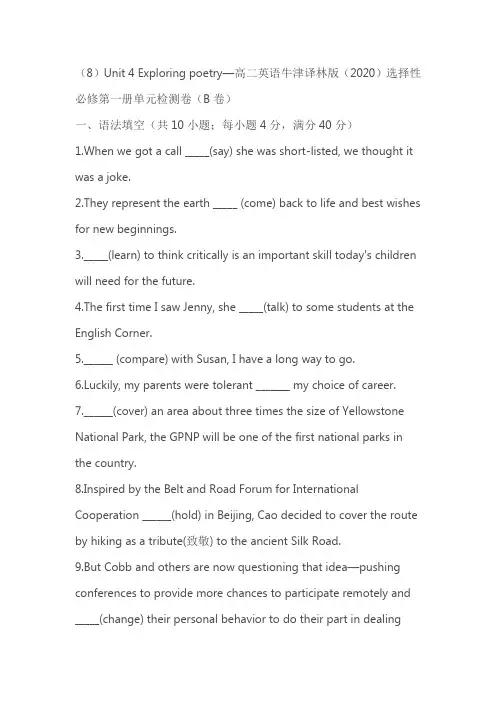
(8)Unit 4 Exploring poetry—高二英语牛津译林版(2020)选择性必修第一册单元检测卷(B卷)一、语法填空(共10小题;每小题4分,满分40分)1.When we got a call _____(say) she was short-listed, we thought it was a joke.2.They represent the earth _____ (come) back to life and best wishes for new beginnings.3._____(learn) to think critically is an important skill today's children will need for the future.4.The first time I saw Jenny, she _____(talk) to some students at the English Corner.5.______ (compare) with Susan, I have a long way to go.6.Luckily, my parents were tolerant _______ my choice of career.7.______(cover) an area about three times the size of Yellowstone National Park, the GPNP will be one of the first national parks in the country.8.Inspired by the Belt and Road Forum for International Cooperation ______(hold) in Beijing, Cao decided to cover the route by hiking as a tribute(致敬) to the ancient Silk Road.9.But Cobb and others are now questioning that idea—pushing conferences to provide more chances to participate remotely and _____(change) their personal behavior to do their part in dealingwith the climate change crisis.10.And when he saw the mists rising from the river and the soft clouds _____(surround) the mountain tops, he was reduced to tears.二、阅读理解(共4小题;每小题5分,满分20分)In 1916, two girls of wealthy families, best friends from Auburn, N.Y.—Dorothy Woodruff and Rosamond Underwood—traveled to a settlement in the Rocky Mountains to teach in a one-room schoolhouse. The girls had gone to Smith College. They wore expensive clothes. So for them to move to Elkhead, Colo. to instruct the children whose shoes were held together with string was a surprise. Their stay in Elkhead is the subject of Nothing Daunted: The Unexpected Education of Two Society Girls in the West by Dorothy Wickenden, who is a magazine editor and Dorothy Woodruff's granddaughter.Why did they go then Well, they wanted to do something useful. Soon, however, they realized what they had undertaken.They moved in with a local family, the Harrisons, and, like them, had little privacy, rare baths, and a blanket of snow on their quilt when they woke up in the morning. Some mornings, Rosamond and Dorothy would arrive at the schoolhouse to find the children weeping from the cold. In spring, the snow was replaced by mud over ice.In Wickenden's book, she expanded on the history of the West and also on feminism, which of course influenced the girls' decision to go to Elkhead. A hair-raising section concerns the building of the railroads, which entailed(牵涉) drilling through the Rockies, often in blinding snowstorms. The book ends with Rosamond and Dorothy's return to Auburn.Wickenden is a very good storyteller. The sweep of the land and the stoicism(坚忍) of the people move her to some beautiful writing. Here is a picture of Dorothy Woodruff, on her horse, looking down from a hill top: "When the sun slipped behind the mountains, it shed a rosy glow all around them. Then a full moon rose. The snow was marked only by small animals: foxes, coyotes, mice, and varying hares, which turned white in the winter."11.Why did Dorothy and Rosamond go to the Rocky MountainsA. To teach in a school.B. To study American history.C. To write a book.D. To do sightseeing.12.What can we learn about the girls from paragraph 3A. They enjoyed much respect.B. They had a room with a bathtub.C. They lived with the local kids.D. They suffered severe hardships.13.Which part of Wickenden's writing is hair-raisingA. The extreme climate of Auburn.B. The living conditions in Elkhead.C. The railroad building in the Rockies.D. The natural beauty of the West.14.What is the textA. A news report.B. A book review.C. A children's story.D. A diary entry.三、七选五(共5小题;每小题4分,满分20分)How to Choose Extracurricular ActivitiesFrom sports to clubs to outside organizations, there are many activities to take part in outside the classroom. ①_______ Fortunately, it becomes quite easy once you figure out what you enjoy doing in general. With a little more careful thought, you can also choose an activity that interests you.Think about your interests and know your advantages. Before you start considering specific(具体的) activities, take a step back. Think about what excites you and find your passions(热情). ②________ Now that you have a better idea of what you like to do in general, decide on those that you are good at. Ask yourself what skills they show. Then find activities that require the same ones. Make sure that you will enjoy yourself by choosing an activity that lets you shine.③________ In addition to your interests and advantages, know what you would like to improve about yourself. Use activities as a way tomake yourself better. Find out new challenges, without the added stress of having to earn good grades at them. You can use activities to develop general skills that you may not have.Find out what activities are available(可用的) and look into each one. ④_______ If the website seems incomplete, talk with your teacher or parents. Also look for calendar details, such asstart-and-end dates, plus event schedules, to make sure it won't get in the way of anything else going on in your life. Once you have a list of activities that match your interests, do a little research.⑤________A. Think about skills you want to develop.B. This can make choosing one a little difficult.C. Use your freshman year to explore your choices.D. In this way, you will have a better idea of what to expect.E. Also make sure that their culture is a good match for your own personality.F. Use those to decide on activities that will keep you interested for a long time.G. Search your school's website for a complete list of all the activities it provides.t四、书面表达(共1题;满分20分)假定你是红星高中学生会主席李华,你校交换生David 上周五面向全体师生作了题为"学英语,讲中国故事"的演讲,反响十分热烈,请你用英语给他写一封邮件表示祝贺和感谢,内容包括:1. 祝贺演讲成功;2. 你的感受。
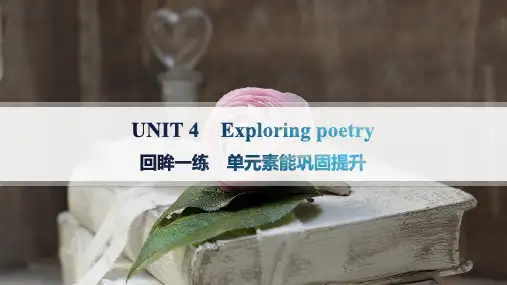

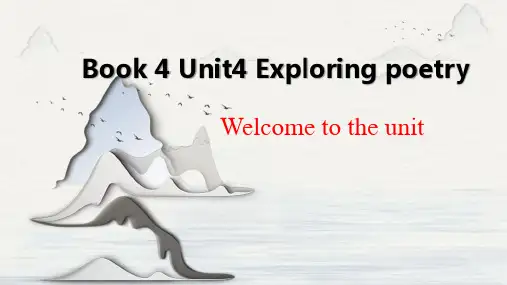

Unit 4 Exploring poetryExtended reading◆内容分析:【What】本板块的语篇话题是“李白和他的浪漫主义诗歌”。
语篇内容紧扣李白诗歌的一个重要艺术特征——浪漫主义风格,着重介绍了其浪漫主义诗风形成的原因,以及诗人李白和他的作品在世界诗歌史上的重要地位和影响力。
【Why】本板块的语篇是一篇关于我国唐代著名诗人李白及其作品的散文,旨在引导学生进一步了解李白、感受李白诗歌的艺术风格与特点,培养和提升学生坚定文化自信,提高自觉传播和弘扬中华优秀文化的意识。
【How】语篇围绕我国唐代著名诗人李白的生平和他的诗歌作品展开,文章结构清晰,层次分明。
开篇以李白早年的一首诗歌入手,引入其浪漫主义诗风的话题;接下来分别从个人经历、历史背景两个层面分析了他浪漫主义诗风形成的原因;再对李白浪漫主义诗歌中充满想象力、情感饱满、善用修辞这些特点加以诠释;语篇最后介绍了李白及其诗歌的重要地位和影响力。
文章大量使用了段落主题句、例证等方式,行文逻辑清晰,理据充分。
◆教学目标:By the end of this section, students will be able to:1. find out the textual structure of the essay and retell the essay based on it;2. sum up the causes that formed Li Bai’s romantic style in his poetry;3. give a list of the features of Li Bai’s romantic style;4. appreciate Li Bai’s poems and recognize his romantic style in them.◆教学重难点:Students will figure out a little bit hard for them to:1. Describe the life of Li Bai and analyse his poems;2. Understand the romantic style and other poets’ different styles.◆教学过程:Step 1 Lead-inEnjoy a video, introduci ng Li Bai’s life by foreign students.After watching the video, students get to talk about what they learn from it and talk more about Li Bai’s life they’ve known before.Step 2 Fast-readingRead the essay and then fill in the following mind map.Answers:1. 2-42. 53. The shaping of Li Bai’s romantic style4. Analysis of Li Bai’s romantic style5. The significance of Li Bai and his poems6. Historical backgroundStep 3 Careful-reading●Read para.1 and read the poem.Translate it into Chinese and then ask a question: What words imply Li Bai’s romantic style?●Read paras.2-4 and fill in the table.What contributes to Li Bai’s romantic style?Answers:1. Studying the classics2. Reading ancient philosophers of different schools3. from legends to historical stories4. famous mountains and great rivers5. different customs and practices6. Economic boom and social stability●Read para. 5 and answer the questions.(1) What are the features of Li Bai’s romantic style poems?There are various features of Li Bai’s romantic style, such as the rich imagination, free expression of strong feelings, plus the wide use of exaggeration, metaphor and other artistic techniques.(2) How does Li Bai show his imagination in his poetry?Li Bai shows his imagination through the moon and stars, the natural landscapes and the figures in legends.(3) What is the biggest difference between Li Bai and other landscape poets?Li Bai breathes vitality into the lifeless objects he describes, which is his free expression of strong feelings.●Read para.6 and answer the questions.(1) What makes Li Bai recognized as the greatest romantic poet after Qu Yuan?The extraordinary imagination, free expression of strong feelings and mastery of language make him recognized as the greatest romantic poet after Qu Yuan.(2) What influences has Li Bai made on the world?Generations of poets, both in China and abroad, owe a debt to his inspirational poems. Today Li Bai’s poetry continues to be enjoyed by countle ss readers around the world. (3) Why is the example of Ezra Pound used in the last paragraph?Ezra Pound is a 20th century American poet. His fascination for Li Bai’s poems is a typical example to explain Li Bai’s significance and influence, which is beyo nd time and space. Step 4 SummaryWrite a summary of the essay on Li Bai’s life and poetry.Sample: Li Bai started writing poetry from a young age. He wrote many poems inspired by what he read, and what he saw when he was travelling, which helped him gain a reputation as a romantic poet. Growing up during the most glorious period of the Tang Dynasty also impacted Li Bai’s poems greatly. Most of his poetry is of the romantic style, featuring rich imagination, free expression of strong feelings and wide use of artistic techniques like exaggeration and metaphor. Li’s works influenced generations of poets. Today they continue to inspire new generations of poets in China and abroad and are still enjoyed by many readers.Step 5 AnalysisAnalyse the following poem by Li Bai to find out more about his romantic style.Sample: This poem displays Li Bai's well-known romantic style. The first line, "Leaving at dawn the White Emperor crowned with cloud", makes me see an image of Li Bai leaving a mountaintop town in his boat on a beautiful morning. The second line, "I've sailed a thousand miles through canyons in a day" and the fourth line "My skiff has left ten thousand mountains far away", suggest that the poet moved away from White Emperor Town and in the direction of the canyons and that he covered many miles a day. In these lines, Li's use of exaggeration reflects his romantic style clearly. The third line uses vivid imagery that assists the reader to understand the sound Li Bai heard from the countless monkeys found along the Yangtze River: "With monkeys' sad adieus the riverbanks are loud". Furthermore, along with the fourth line, it gives me the sense of how fast his boat was moving down the river as well as how happy and excited Li Bai felt. The free expression of strong feelings is really impressive. This poem also shows where he was travelling and how his travel greatly inspired his poetry.Step 6 Language points1.Word study: striking & characterize◆Introduce the meaning of striking together with the following exercise.Her big eyes are her most striking feature. (最显著的特点)。